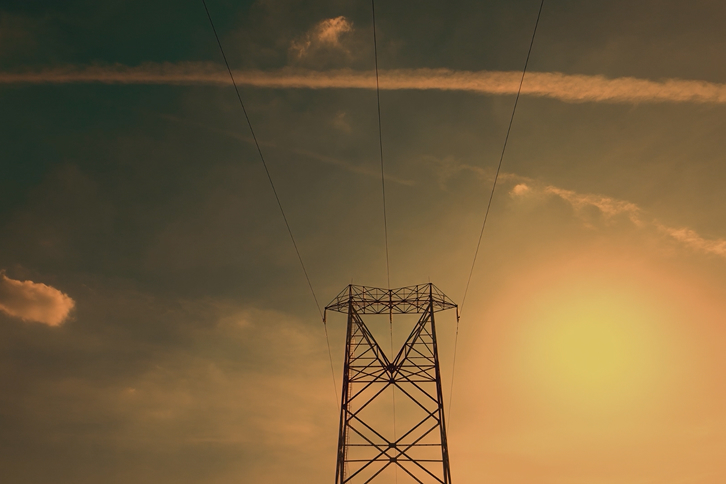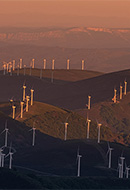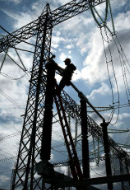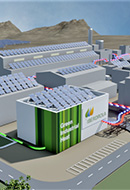IEA World Energy Outlook 2024
The International Energy Agency heralds the ‘Age of Electricity’
Energy efficiency Sustainable mobility Decarbonisation Climate change
The latest edition of the International Energy Agency's (IEA) 'World Energy Outlook 2024' report offers a comprehensive analysis of the current and future energy landscape, highlighting the pivotal role of electricity in this new era. Dubbed the “Age of Electricity,” this phase is marked by an accelerated shift from fossil fuels to cleaner energy sources like wind, solar and hydroelectric power.

With our Strategic Plan 2025-2028 we have reaffirmed our commitment to building a sustainable and secure energy future.

Welcome to the era of electrification
The IEA’s Executive Director, Fatih Birol, emphasised that the global energy system is undergoing a transformation comparable to the shift from coal to oil in the past, with electricity set to dominate the future landscape. He highlighted how this transition, driven largely by renewable-energy sources, is expected to see more than half of the world’s electricity coming from low-emission technologies before 2030. However, the report warns that progress remains uneven across regions, and calls for increased investment to make clean energy more accessible and resilient on a global scale.
In addition to electricity's central role, the World Energy Outlook 2024 addresses key geopolitical and economic pressures on energy security, especially in light of recent global conflicts. The IEA projects that by the end of the 2020s, demand for fossil fuels like oil, coal and natural gas will peak, while clean energy investments will reach unprecedented levels. This shift presents significant opportunities to mitigate climate change, though the report also highlights the substantial work that remains to reach international climate goals, such as limiting global warming to 1.5ºC.
What is the World Energy Outlook report?
The World Energy Outlook (WEO) report is the flagship publication from the International Energy Agency (IEA), which is an intergovernmental organisation that provides policy recommendations, analysis and data on the global energy sector. The report is considered to be the most authoritative global source of energy analysis and projections, identifying the biggest trends in both energy demand and supply, and examining what these mean for energy security, emissions and economic development. The WEO 2024, as this latest edition published in October 2024 is known, examines not just how far the world has come on the journey toward a more sustainable global energy system, but also considers what more needs to be done if climate goals – such as limiting the warming of the planet to 1.5ºC – are to be achieved.
The report also points to the major risks that are being caused by geopolitical tensions both in the case of energy security and when it comes to taking global action to reduce emissions of greenhouse gases. Projections from the IEA suggest that the world will enter a new energy market context in the coming years, characterised by an abundant supply of multiple fuels and technologies, including oil and liquefied natural gas.
The ‘Age of Electricity’
On the release of the report, Fatih Birol, the Executive Director of the International Energy Agency (IEA), heralded the arrival of the “Age of Electricity”, something that he said will “define the global energy system” from now on. “In energy history, we’ve witnessed the Age of Coal and the Age of Oil,” Birol said. “We're now moving at speed into the Age of Electricity, which will define the global energy system going forward and increasingly be based on clean sources of electricity.”
The report predicts that more than half of the world’s electricity will come from low-emission sources before the year 2030. But it warned that the deployment of clean energy is “far from uniform” on an international scale. What’s more, the report predicts that demand for fossil fuels such as oil, gas and coal will peak by the end of the 2020s, with clean energy “entering the energy system at an unprecedented rate”. A full 560 gigawatts (GW) of renewable energy capacity was added to the global system in 2023, the report finds, while around $2 trillion is due to be invested in clean energy in 2024, almost double what will be allocated to fossil fuels in the same period.
Rising demand for electricity and the persistence of coal
The IEA says that by 2035 global electricity demand will be 6% higher than it was predicting as recently as last year, and expects the world to add the equivalent of Japan’s annual electricity requirements each year (909 terawatt hours). This demand is being driven by a variety of factors, such as the need for air conditioners in countries that are suffering ever-more-brutal heatwaves, like India, power-hungry data centres, new factories and also electric vehicles, the report states.
The growth in clean power generation has not, however, kept pace with this rising global demand for electricity. The IEA predicts this trend will continue, meaning that the use of coal to generate power will decrease more slowly than had been expected. In the United States, for example, some utility companies are extending the life of coal-fired power plants rather than sticking to plans to retire them.
But the IEA also points to enough low-emissions power plants coming online by the end of the 2020s to meet that rise in demand. These plants, the Paris-based agency says, will be primarily wind, solar and nuclear. This increase in capacity could see the use of fossil fuels such as coal, oil and natural gas peak over the course of the current decade, and prevent the global emissions of greenhouse gases from increasing too drastically.

What is electrification?
Advantages of electrification

Investment in smart grids
A key pillar to boost the world's energy transition

Industrial electrification
Electifying industry enables more efficient energy use and fosters innovation.
Energy security and geopolitical strains
The IEA report points to the effect that conflicts such as the one that broke out in the Middle East in 2023 have on the flow of oil, with a major potential for disruption. Some 20% of global oil and liquified natural gas (LNG) supplies, for example, flow through the Strait of Hormuz, which is a “maritime chokepoint” in the region. The solution, the agency suggests, is to accelerate the translation to “clean and more secure technologies” in order to move away from dependence on fossil fuels. What’s more, the IEA also pointed to the ongoing efforts by the United States and Qatar to build terminals for the export of liquified natural gas (LNG). This could lead to an “oversupply” of LNG in the 2020s, something that could push down global energy prices and avoid the kinds of price spikes suffered by some countries after Russia invaded Ukraine back in 2022.
“In the second half of this decade [the 2020s], the prospect of more ample – or even surplus – supplies of oil and natural gas, depending on how geopolitical tensions evolve, would move us into a very different energy world,” IEA Executive Director Fatih Birol said. “It implies downward pressure on prices, providing some relief for consumers that have been hit hard by price spikes. The breathing space from fuel price pressures can provide policymakers with room to focus on stepping up investments in clean energy transitions and removing inefficient fossil fuel subsidies. This means government policies and consumer choices will have huge consequences for the future of the energy sector and for tackling climate change.”
Oil demand change forecast thanks to transition to electric vehicles
Million barrels per day (mb/d)
- 60
- 40
- 20
- 0

- 2010
- 2023
- 2030
- 2035
- Road transport oil demand
- Avoided oil demand from EVs
This forecast from the IEA is made under their Stated Policies Scenario (STEPS), which is a model the organisation has developed to provide a baseline view of how global energy systems might evolve if governments continue with their currently announced and implemented policy commitments, without additional or more ambitious measures to address climate change.
Source: International Energy Agency (IEA)
Growing sales of electric vehicles, for example, could see the global demand for oil plateau as the current decade progresses, while the IEA also expects a “large surfeit” of manufacturing capacity for some of the key clean energy technologies, such as solar PV and batteries.
The world is a ‘long way’ from its climate goals
The demand for oil and gas is expected to peak before the end of the 2020s, according to the IEA’s analysis, but the world is still on pace to reach 2.4ºC of global warming by the end of the century. This is well above the Paris Agreement objective of limiting the temperature increase to 1.5ºC, and will entail “ever more severe risks from a changing climate”, according to the WEO 2024 report. The IEA states that decisions taken by governments, investors and consumers too often entrench the current flaws in the energy system, rather than pushing it towards a clean and safer path. The report points to the costs of climate inaction, which will increase day by day as emissions accumulate in the Earth’s atmosphere and the resultant extreme weather wreaks havoc. Clean-energy technologies, meanwhile, will remain cost-effective, according to the report, enjoying a low exposure to the commodity markets and providing “lasting benefits for people and the planet”.
Electricity grids: Preparing the energy transition for the future
Despite the clear progress in the transition to clean energy highlighted in the WEO 2024 report, the document concludes that increased investment in new systems, especially electricity grids and energy storage, is still needed. For every dollar invested in renewable energy, 60 cents goes to grids and storage, according to the International Energy Agency (IEA), highlighting that essential support infrastructure is not evolving at the same pace as clean generation. ‘The safe decarbonisation of the electricity sector requires investment in grids and storage to grow even faster than clean generation, with the ratio rebalancing towards 1:1’, says the IEA.
Emerging technologies are accelerating demand for electricity, but the current infrastructure is not ready to respond. Electricity grids –those vast connections of cables and substations that supply homes and businesses– are fundamental to modern life, yet they rarely receive attention until they fail. According to the WEO 2024, global electricity demand will double by 2050. To meet it, 80 million kilometres of grid –equal to the entire current electricity grid– will need to be replaced or expanded in just 15 years.
Modernising grids does not just mean replacing old infrastructure: it involves building smarter, more flexible systems. Smart grids can adapt in real time to changes in consumption and integrate diverse sources, including energy generated by users themselves. Combined with smart meters, they offer greater efficiency and, potentially, lower costs for consumers. The challenge, however, is enormous. The IEA estimates that annual investment will need to double to $600B by 2030, backed by strong policies, a shared vision and coordinated action.
The new Global Grids Index External link, opens in new window. , compiled using data from BloombergNEF, analyses the readiness of 10 key countries to build next-generation electricity grids. Germany tops the ranking, but all countries –including the United States, which ranks fifth– face significant challenges. The US grid, for example, is not only ageing, but also constrained by fragmented regulation and uneven progress in digitalisation and storage.
External link, opens in new window. , compiled using data from BloombergNEF, analyses the readiness of 10 key countries to build next-generation electricity grids. Germany tops the ranking, but all countries –including the United States, which ranks fifth– face significant challenges. The US grid, for example, is not only ageing, but also constrained by fragmented regulation and uneven progress in digitalisation and storage.
The IEA has also found that many clean energy projects in developing economies are being held back by a lack of clear policies and high capital costs. In advanced economies, the picture is a mixed one, with progress in some sectors and setbacks in others, such as the decline in heat pump sales in Europe in the first half of 2024. The report also highlights the delay in meeting key commitments made at COP28 in 2023, including the goal of doubling the global rate of improvement in energy efficiency, which seems difficult to achieve with current policies.
China as a model for renewable energy
China merits special attention in the World Energy Outlook 2024. Electricity use has grown at twice the pace of overall energy demand over the last decade, with two-thirds of the global increase in electricity demand over the last 10 years coming from China, the IEA reports. The superpower is currently the world’s biggest emitter of greenhouse gas emissions, but it is also the principal manufacturer of solar panels and batteries for energy storage. Electric vehicles account for 40% of new car sales in the country (and 20% of sales globally), while solar-power generation from China alone could exceed the total demand for electricity in the United States by the early 2030s.
China’s coal demand, 2023 and 2035 IEA forecast
Thousand Mtce*
- 5
- 4
- 3
- 2
- 1
- 0

- 2023
- 2035
- Coal
- Avoided through clean energy technologies
*Mtce= Million tonnes of coal equivalent.
Source: International Energy Agency (IEA).
“As with many other global energy trends today, China is a major part of what is happening,” Dr Birol added. “Whether it’s investment, fossil fuel demand, electricity consumption, deployment of renewables, the market for EVs, or clean technology manufacturing, we are now in a world where almost every energy story is essentially a China story. Just one example: China’s solar expansion is now proceeding at such a rate that, by the early 2030s – less than 10 years from now – China’s solar power generation alone could exceed the total electricity demand of the United States today.”
Iberdrola, a clean, reliable and smart business model
Iberdrola is one of the world's leading producers of clean energy and storage solutions, as well as one of the world's largest electricity companies. This position offers it a unique perspective on energy trends and a clear view of the scale of the challenge. In 2024, the company allocated $13 billion to grids, with a significant portion of that investment in the United States, where its subsidiary Avangrid has been committed to developing grids in the northeast of the country for two decades.
"The United States is one of Iberdrola's main investment destinations," says Ignacio Galán, the company's executive chairman. "We’re working to modernise, expand and digitise grid infrastructure, enabling the expected increase in electricity demand."
Electrification is key to security of supply, resilience and better use of resources. It also means competitiveness, investment opportunities and environmental protection, providing energy independence and quality jobs. Gonzalo Sáenz de Miera, Director of Climate Change and Partnerships at Iberdrola, analyses the keys to the electrification of the economy and its fundamental role in the current context.

Electrification, key in today's world, with journalist Pedro Piqueras and Gonzalo Sáenz de Miera, Director of Climate Change and Partnerships at Iberdrola.





